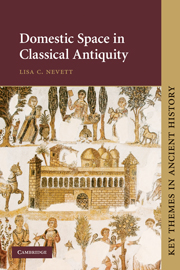Book contents
- Frontmatter
- Contents
- List of figures
- List of plates
- Preface and acknowledgements
- Map showing the locations of the sites and regions discussed in Chapters 3–6
- Introduction
- 1 Domestic space and social organisation
- 2 House-form and social complexity: the transformation of Early Iron Age Greece
- 3 A space for ‘hurling the furniture’? Architecture and the development of Greek domestic symposia
- 4 Housing and cultural identity: Delos, between Greece and Rome
- 5 Seeking the domus behind the dominus in Roman Pompeii: artefact distributions as evidence for the various social groups
- 6 Housing as symbol: elite self-presentation in North Africa under Roman rule
- Epilogue: domestic space and social organisation in Classical Antiquity
- Glossary
- Period names and dates referred to in this book
- Bibliographic essay
- Bibliography
- Index
6 - Housing as symbol: elite self-presentation in North Africa under Roman rule
Published online by Cambridge University Press: 05 August 2012
- Frontmatter
- Contents
- List of figures
- List of plates
- Preface and acknowledgements
- Map showing the locations of the sites and regions discussed in Chapters 3–6
- Introduction
- 1 Domestic space and social organisation
- 2 House-form and social complexity: the transformation of Early Iron Age Greece
- 3 A space for ‘hurling the furniture’? Architecture and the development of Greek domestic symposia
- 4 Housing and cultural identity: Delos, between Greece and Rome
- 5 Seeking the domus behind the dominus in Roman Pompeii: artefact distributions as evidence for the various social groups
- 6 Housing as symbol: elite self-presentation in North Africa under Roman rule
- Epilogue: domestic space and social organisation in Classical Antiquity
- Glossary
- Period names and dates referred to in this book
- Bibliographic essay
- Bibliography
- Index
Summary
The scenery offers much variety, in some places the route is blocked by trees, in others it takes in wide meadows, where large flocks of sheep and herds of cattle…thrive in the spring sunshine, and on the fertile grazing. My villa is a convenient size…Tell me, now, don't I have good cause for living in, staying at, loving, such a place.
Pliny the Younger, Letters 2.17Considering power dynamics…at the scale of the household may yield insights into how…certain household members acquired or reproduced social status or economic wealth in the larger context of their community or society.
Hendon 2005, 186INTRODUCTION
In previous chapters discussion has centred on the way in which the physical remains of ancient houses can be used as a means of exploring some of the social and cultural patterns by which those houses were shaped. In this chapter I shift the focus onto the representation of the domestic sphere, using the material record to look at the way in which a house can play a symbolic role as an expression of the ideas and values of its owner. To do so, I look at housing from North Africa between the second and fifth centuries ce, which is particularly well known for its large numbers of distinctive polychrome mosaic floors. It is these mosaics, and some of the ways in which their iconography seems to have been manipulated by the members of the North African elite to convey a distinctive ideology, which are the subject of this chapter.
- Type
- Chapter
- Information
- Domestic Space in Classical Antiquity , pp. 119 - 141Publisher: Cambridge University PressPrint publication year: 2010



